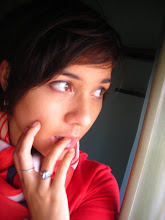
Sometime before Christmas, I had a conversation over FacebookChat with one of my good friends from high school, concerning our respective heritages. She's an American Jew who has been to Israel not once, but twice, and seems to know a lot about her family and her people. I, on the other hand, reflected on what I know about my grandparents' homeland, and came up almost empty handed. Originally settled by the Spanish, I think? Comprised of more than 7 thousand islands (I remember tracing a map of the archipelago for a Multicultural Day presentation I did in third grade), with as many dialects. Main crop: rice. And... my info stops there. When I told her that I wanted to know more, to go to the Philippines and get in touch with my roots, she half-jokingly suggested that I write a short report about the Philippines and send it to her in Colorado. "I expect one to two pages about your history, in one month!," she had said. I said, "Okay. I think you're kidding, but I'm going to do it for real." A small, personal research. I can begin at any time, right? I don't have to go all the way to the Philippines to start to know myself.
Well, one month turned into two months, but in the end I wrote up a little something. It didn't come only from Wikipedia, but a handful of travel sites, personal blogs, news articles. From just a few hundred words I learned a lot that I didn't know before, and now I'm even more fascinated by my ancestors than I already was. Check it out:
The Philippines
A Report by Lauren Aczon
3 January 2009
A Report by Lauren Aczon
3 January 2009
.jpg)
The second smallest one in the front row is Clotilde Albano; my grandma. This was likely taken in the mid-1920s. Click on it to see it up close.
But this is all Now. We want some History.
The history of the Philippines bears Asian, European and American influence. Prior to Spanish colonisation in 1521, the Filipinos had already established strong trade relationships with China and Japan. My family's region, found at the northernmost tip of the country and divided into Ilocos North and Ilocos South, was famous for its gold mines, and exchanged this gold for beads, ceramics and silk. Spain's presence in the early 1500s brought about the construction of Intramuros, a "Walled City" comprised of European buildings and churches which was then replicated throughout the country. After 350 years and 300 rebellions, the Filipino people finally won their independence in 1898... but not for long.
In the same year, it became the first and only colony of the United States. (!!!!) Following the Philippine-American War* the U.S. brought widespread education to the Islands. Most standardised education is taught in English, even today. The two countries fought side by side in the Second World War, particularly at the famous battles of Bataan and Corregidor which delayed Japanese advance and virtually saved Australia. Among the ranks was my father's father, Benjamin Aczon, was in the United States Navy. The Filipinos waged a guerilla war against the Japanese from 1941-1945, an effort that - as far as we know - left the majority of the village's women and children at the mercy of the occupying Japanese military as the able Filipino men retreated to neighboring hills to train. It was subsequently after this guerilla war period that my grandmother left the Islands in 1945, never to return. I don't remember her ever talking to us about what happened in the years before she left.
* (1899-1913) The Philippine-American War arose from the first republic's struggle against U.S. annexation. The first portion of this war, from 1899 to 1902, was an armed military conflict that is also known as the Philippine Insurrection. Over 1 million Filipino civilians perished.
The Philippines regained their independence in 1946.
Travel sites describe the country as festive and welcoming. "The Filipinos are a freedom-loving people," says one, "having waged two peaceful, bloodless revolutions against what were perceived as corrupt regimes." One of those was that of President Ferdinand Marcos whose regime was often compared to Stalin, Mao Zedong, and Hitler. After embezzling millions of dollars of public funds to the United States, he was removed from power by the Filipino people on February 25th, 1986 -- the day that I was born.
The End.
Or rather, a beginning.


No comments:
Post a Comment